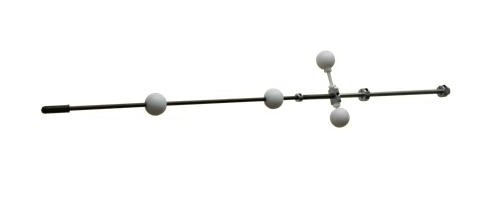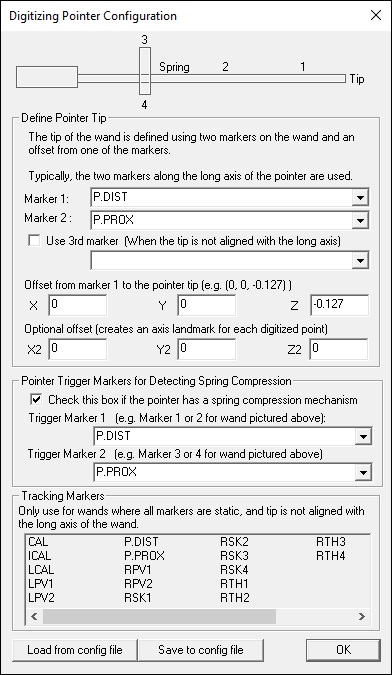Digitizing Pointer Configuration
Defining the digitalizing pointer so the TIP of the pointer can be computed.
There are two general types of pointers.
- Spring loaded - allows Visual3D to recognize when the tip location should be assigned to a landmark; e.g. when the spring is compressed.
- Static - The user must select a button to notify Visual3D to assign the tip location to a landmark.
In both cases, the pointer can be tracked with any number of markers, not just those used to define the location of the landmark.
Configuration Dialog
Pointer Dimensions
There is a set screw on the marker closest to the tip, which means that the location of the marker is variable.
In addition, there are two different tips on the marker; the bigger tip can be pulled off to reveal the smaller tip.
Because of this variability it is important that each lab measure the distance from the center of the marker to the tip.
This means that the value for the z-offset in the figure above should be set uniquely for each laboratory.
The travel of the marker doesn't matter too much, but Visual3D assumes the pointer is extended during the static trial because this is the start position for estimating the travel.
Custom Pointer Configurations
The Visual3D Digitizing Pointer module can be configured for any custom digitizing pointer that uses motion capture markers to locate the pointer in a 3D volume.
Pointers equipped with a “trigger mechanism” can trigger an event that will help Visual3d identify frames of interest automatically. For example, The Davis Pointer has a spring in the housing that can be compressed with the tip located at the anatomical landmark of interest. Compressing the spring causes the motion capture markers to move closer together. Visual3D can identify events associated with the spring compression, and thus can determine the anatomical landmarks automatically.
Other pointers, such as those that are used commonly with Northern Digital cameras require a separate external trigger, or the user must identify the events manually, which actually isn't a terrible burden because it is necessary to verify the events even when the process is automatic. Verification is required because the user may change their mind and choose to digitize the same landmark twice (e.g. because the tip slipped on the first attempt). The result is that this erroneous event must be deleted.
Model Template
The Model Template contains the configuration of the digitizing pointer and the definition of the digitizing landmarks. In most cases the user simply needs to open the model template to load the pointer and landmark definitions.


